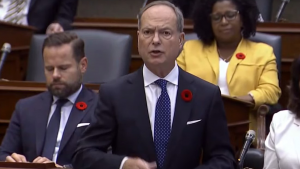Canada has been caught on its back foot several times in its attempts to keep environmental commitments. Remember the well-publicized pledge to plant two billion trees? It never happened.
The White House “Buy Clean” initiative announced in late 2021 clearly placed the U.S. on a path towards addressing climate change. Canada has the opportunity to either step up or take a knee.
Take carbon, for example. Construction has an enormous role to play in reducing carbons, both operational and embodied. It’s therefore interesting to note a specific section of the U.S. announcement related to the industry.
“In 2022, the General Services Administration (GSA) will require contractors to disclose the embodied carbon of building materials for new building and major modernization contracts.”
The U.S. federal government is looking beyond 2022. Over the next two decades, it will require, “net-zero emissions from federal procurement no later than 2050, including a Buy Clean policy to promote use of construction materials with lower embodied emissions.”
And Canada?
Responsibility for reducing carbon emissions and carbon embodiment in federal projects spans several federal ministries: Natural Resources Canada; Public Services and Procurement Canada; Infrastructure Canada; and Environment and Climate Change Canada.
That’s a lot of players. However, at the top of the ladder and ultimately holding the purse strings is the Treasury Board of Canada Secretariat (TBS).
According to its website, “The Treasury Board of Canada acts as the management board for the Government of Canada.” Among its responsibilities, the TBS, “establishes policies for the government’s real property, fleet and procurement…It provides oversight of the government’s financial management and spending.”
Asked directly about the U.S. Buy Clean policy announcement, the TBS responded by referring to a dizzying array of Canadian programs and initiatives it says addresses the issue of carbons relating to government procurement.
Ready?
One is called the Greening Government Strategy, part of the Federal Sustainable Development Strategy established in 2017 and updated in 2020, and led by the Centre for Greening Government created in 2018. Like the Americans, it has an overall long-term target of net-zero emissions by 2050.
Then there’s the Policy of Green Procurement, introduced in 2006 and updated in 2018. It requires federal departments and agencies, “to integrate environmental considerations into procurement activities.”
And let’s not overlook the Directive on the Management of Procurement requiring departments to include “where appropriate” environmental considerations.
All these strategies, programs and initiatives are in addition to the environmental files within the other ministries listed above.
Similar to the U.S., Canada also has near term targets, some of which are described in the above-mentioned Greening Government Strategy.
These are: “Disclosure of the amount of embodied carbon in the structural materials of major construction projects by 2022, based on material carbon intensity or a life-cycle analysis; Reducing the embodied carbon of the structural materials of major construction projects by 30 per cent, starting in 2025, using recycled and lower-carbon materials, material efficiency and performance-based design standards; and conducting whole building (or asset) life-cycle assessments by 2025 at the latest for major buildings and infrastructure projects”
These appear to line up with the U.S. Buy Clean announcement. But Canadian environmental experts would like to see more.
Felix Whitton, senior policy adviser with Clean Energy Canada, told the Daily Commercial News while Canada’s various initiatives are a good start, more should be done and faster.
Specifically, Clean Energy Canada is calling for a $500 million Clean Infrastructure Demonstration Fund to showcase low-carbon materials in infrastructure projects, and a Buy Clean policy covering all manner of infrastructure like roads, bridges, hospitals and schools.
“This will make a much bigger climate impact and underpin a much larger market for low-carbon materials.”
Whitton adds aligning with the U.S. on embodied carbon data and reporting could have an important outcome for Canada’s construction industry as well.
“This will not only help exporters and businesses with operations in both countries but will also make a strong case that Canadian products should be exempted from Buy American requirements.”
John Bleasby is a Coldwater, Ont.-based freelance writer. Send comments and Climate and Construction column ideas to editor@dailycommercialnews.com.











Recent Comments
comments for this post are closed